Stories
Chris Leonard
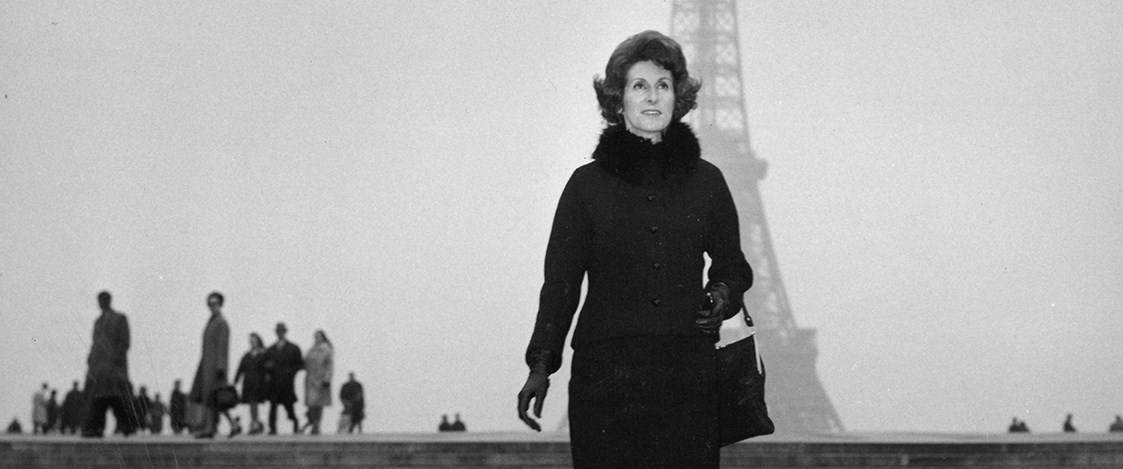
In the early 1960s, the stars of fashion design competitions were glamorous ballgowns. Not only did they give designers a chance to demonstrate their skills, they enabled fashion-conscious women to feed their fantasies. One designer specialising in gala gowns was Aucklander Chris Leonard. Her creations, a rich mix of opulent fabrics and ornamentation, won her many accolades, including trips to Italy and Paris.
Chris developed a love of fashion at a young age. In her teens, she was a champion ballroom dancer and, during World War II, made the dresses in which she performed. Always artistic, she had earlier won a place at the Elam School of Fine Arts but, due to a family member’s illness, did not take it up.
Prior to her marriage, Chris owned a Grey Lynn boutique which she ran in tandem with a business making American label swimsuits under license. When her youngest daughter started school, she began designing clothes. Completely self-taught, she never received any formal training in either dressmaking or design.
Interestingly, one of Chris’s first fashion wins was not for a ballgown but for a two-piece racewear outfit. An example of ensemble dressing at its most luxurious, it comprised a bright pink silk trapeze coat worn over a matching dress whose bouffant skirt had a scalloped hem trimmed with hand-made roses. The winner of the Racewear Section in the 1962 Golden Shears Awards, organised by the Professional Mannequins Association of New Zealand, it was modelled on the night by Diane Cooper.
Chris Leonard's winning racewear design, modelled by Diane Cooper, 1962.
Diane liked the design so much she had Chris make her something similar for her going-away outfit when she married for the first time in 1964. "It was emerald green silk," she recalls. "I adored Chris’s clothes." Chris also made Diane’s wedding gown.
A photograph of Diane modelling a backless Chris Leonard evening gown with hand-made fabric flowers falling in a trail from waist to hem, illustrates the designer’s ability to orchestrate the grand exit as well as the grand entrance.
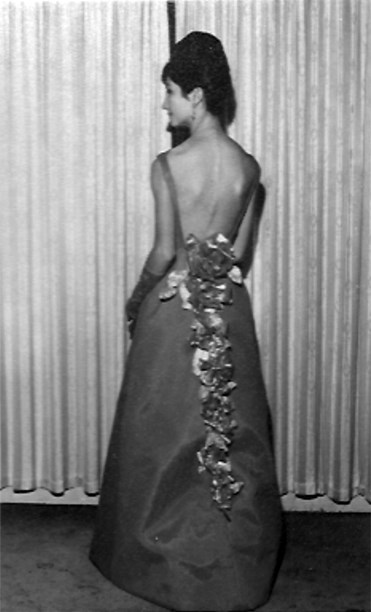
Diane Cooper wearing a Chris Leonard evening dress with fabric flowers trailing from waist to hem. Image courtesy of Christina Moynihan.
Chris’s 1963 award-winning Gown of the Year also featured a back panel of roses made to match those decorating the hem. Called 'Sapphire', the blue satin gown, judged the winning design by public vote, had a strapless bodice and a crinoline skirt constellated with rhinestones. One of 13 entries in the fifth Gown of the Year show co-ordinated and compered by Tam Cochrane, it appeared on-stage concealed by a floor-length matching cloak, removed later for a dramatic reveal.
‘Sapphire’, Chris Leonard’s 1963 Gown of the Year. Image courtesy of Christina Moynihan.
Chris’s prize was one week in Paris where she visited the fashion houses of Givenchy and Yves Saint Laurent and received an invitation to view Christian Dior’s 1964 Printemps-Été (Spring/Summer) collection at the Dior atelier on the Avenue Montaigne. She attended a performance of the ballet and, at a candlelight dinner in a restaurant in the cellars of an ancient convent, was served by waiters dressed in velvet page-boy costumes.
Chris Leonard (centre) discusses her itinerary for her Gown of the Year prize - a free trip to Paris including an invite to see a Christian Dior show - with competition organiser Tam Cochrane and Air France general manager H Sigerist. Image © New Zealand Herald.
Photographs of Chris out and about in Paris and having her makeup done at the Harriet Hubbard Ayer Beauty Institute and her hair styled by the famous French coiffeur Alexandre, appeared in the New Zealand Woman’s Weekly. The magazine reported on the trip and Chris’s red-carpet treatment in some detail, no doubt inspiring other designers to participate in the final Gown of the Year competition the following year.
Chris Leonard in Paris. Photos courtesy of New Zealand Woman’s Weekly.
On her way home from Paris, Chris enrolled in a tambour beading (beaded embroidery) course at the Royal School of Needlework in London. She applied this technique to 'Italiana', her entry in the 1964 Gown of the Year. A hot pink evening dress, cut on sculptured lines, it was placed fifth in the competition.
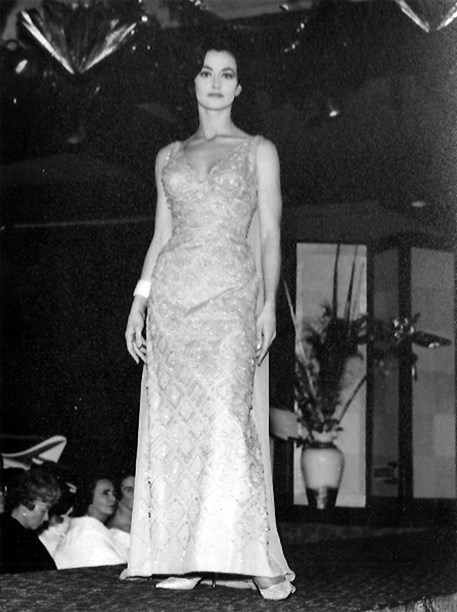
‘Italiana’, placed 5th in the 1964 Gown of the Year. Image © Christina Moynihan.
In 1973, Chris won the Supreme Award in the Cameo New Zealand Fashion Showcase, a design contest started in 1966 by Peggie Wilson, the principal of the Academy of Elegance. Originally known simply as the New Zealand Fashion Showcase, the name change came about in 1973 when Rothmans of Pall Mall, makers of Cameo Mild cigarettes, became the event’s major sponsor. For the first time, the judging panel included an international fashion expert, Dr Amos Ciabattoni, the general manager of the Combined Fashion Houses of Italy. Profits from the four shows, two in Auckland, two in Christchurch, were presented to Schools for the Deaf in both cities.
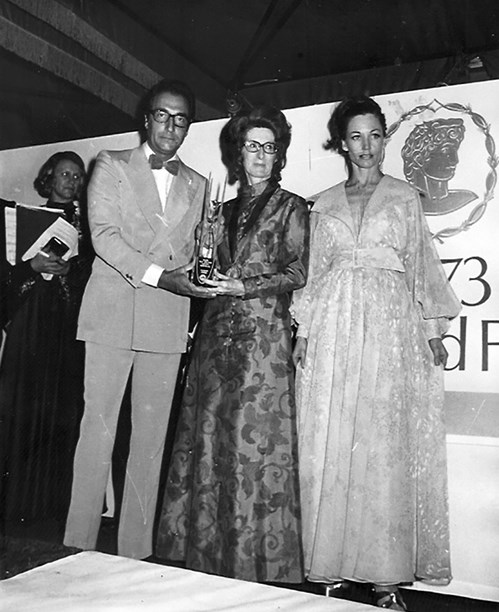
Chris Leonard (centre) receiving the 1973 Cameo Award from Dr Amos Ciabattoni. The model on her left wears the winning gown. Image © Christina Moynihan.
With its wide collar, voluminous, tightly cuffed sleeves, and waist cinched by a buckled sash, Chris’s award-winning green chiffon dress exemplified the Seventies’ more informal approach to evening. A four-week return trip for two to Italy, where she was hosted by Dr Ciabattoni, was part of her prize.
When not creating one-off show-stoppers, Chris devoted her time to running a successful business. With two assistants, she designed, cut and sewed exclusive model garments under her own name. These she sold through a few select fashion establishments in Auckland, Wellington, Christchurch and Double Bay in Sydney, then in her own Parnell boutique which she opened in 1974 on her return from Europe. Although proficient in all areas of fashion, her name became synonymous with clothes for special occasions. She enjoyed working with sumptuous fabrics, Thai silk, which she loved for its texture, patterns and glowing colours, being one of her favourites.
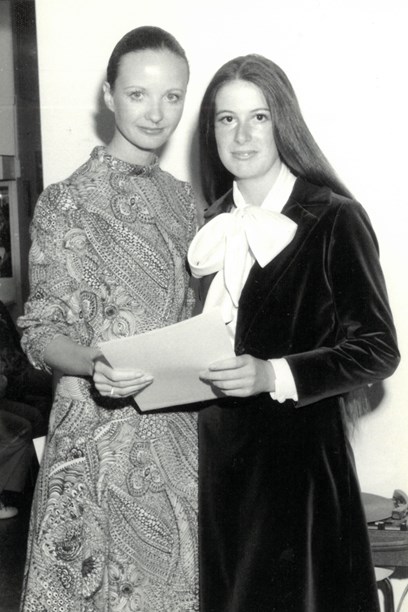
Chris Leonard's daughter Christina (right) with Maysie Bestall-Cohen after the final parade of her modelling course at the June Dally Watkins Deportment School and Model Agency, 1971. Christina is wearing a bottle green velvet coat dress and cream satin shirt designed by her mother. Image © Christina Moynihan.
Until moving to Australia in 1979, ostensibly to retire, Chris continued to pick up fashion awards. The Apparel Cup of Fashion Elegance, a race-day win at Ellerslie, was among those to receive mention in the Auckland Star.
Her retirement didn’t last long. After a few years in Australia, she resumed work as a designer in a different capacity and on a much larger scale. Using the name Chris Leonard as she had in New Zealand, she designed three to four ranges a year, mainly daywear with some silks for evening. With each style being produced in the hundreds, huge volumes of her garments were sold throughout Australia in boutiques and large department stores such as David Jones.
Chris Leonard’s long career ended in 1993 due to a stroke, and her label was sold five years later. Her daughter Christina Moynihan describes her mother as a true designer, inspired by colours and nature, and thinking up new designs every minute of the day and night. "She was very creative. For all those years, the ideas just kept flowing. Growing up in such an environment, life was glamorous, high profile and never boring."
Text by Cecilie Geary. Banner image of Chris Leonard in Paris in 1964, courtesy of New Zealand Woman’s Weekly.
Published December 2019.